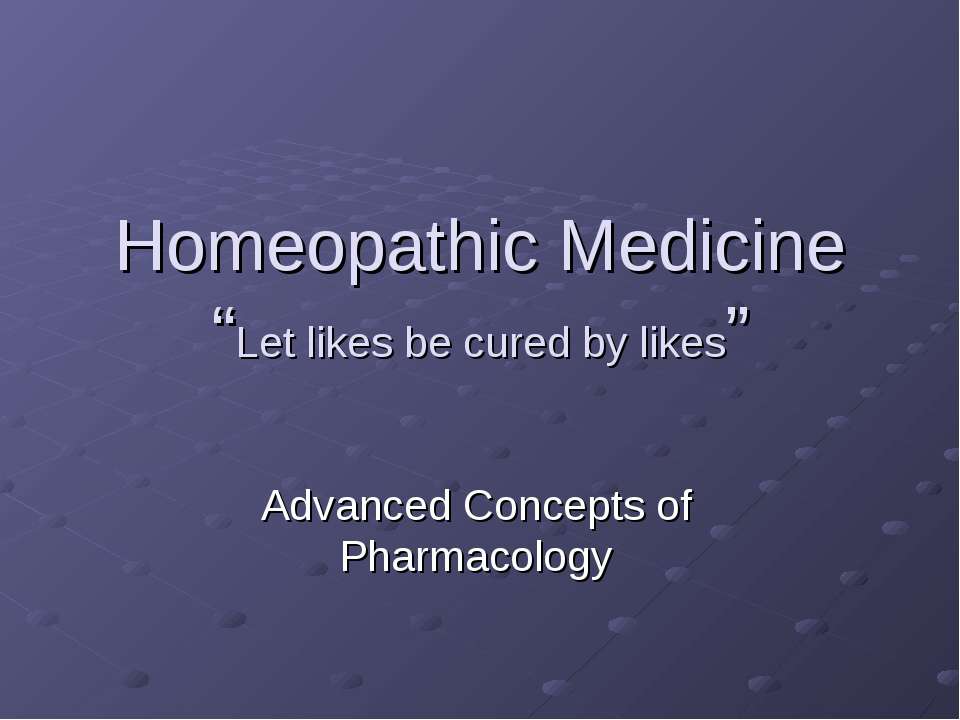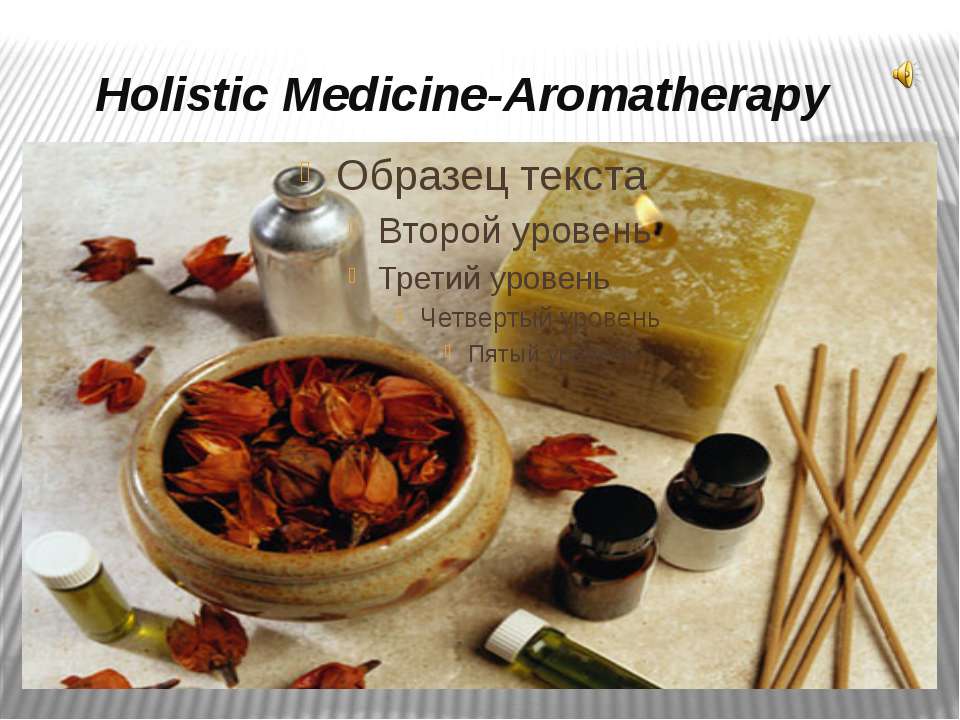Homeopathic Medicine “Let likes be cured by likes”

- Рубрика: Презентации / Презентации по английскому языку
- Просмотров: 363
Презентация "Homeopathic Medicine “Let likes be cured by likes”" онлайн бесплатно на сайте электронных школьных учебников edulib.ru
Outline Homeopathic medicine and its history The Principles of homeopathic medicine How homeopathy differs from traditional medicine and herbalism How homeopathic medicines are made How to use homeopathic medicines Compatibility, side effects and overdosing
Alternative Medicine The use of alternative medicine is growing significantly in the U.S. According to a study published by JAMA, 4 out of 10 Americans use some form of alternative medicine. The most common forms of alternative medicine are homeopathy, massage, meditation, therapeutic touch, acupuncture and herbal remedies.
What is Homeopathy? Homeopathy is a system of medicine whose principles are even older than Hippocrates. It seeks to cure in accordance with natural laws of healing and uses medicine made from natural substances: animal, vegetable and mineral. “Discovered” in the early 1800s by a German physician, Samuel Hahnemann. Hahnemann became disillusioned with the brutal and senseless treatment methods (bleeding, purging and cautery) of the day.
Samuel Hahnemann and Homeopathic History Hahnemann eventually gave up the practice of medicine and turned to medical translating. While translating a Scottish professors medicine book he stumbled across the key to curing sick people. The author claimed that quinine could cure malaria because of its “astringent and bitter” qualities. Hahnemann decided to test it on himself and found that by taking quinine he could induce the symptoms of malaria in himself. He reasoned that malaria was cured by quinine, not because of its bitter taste but because the drug produces the symptoms of malaria in a healthy person.
Homeopathy History In 1890, there were 14,000 homeopaths compared to 100,000 conventional physicians. In some areas, one out of four physicians was a homeopath. There were 22 homeopathic medical school and over 100 homeopathic hospitals. The rise of the drug industry after the Civil War changed the practice of medicine and by 1940’s the homeopathic physician was almost obsolete.
Homeopathy Statistics Homeopathy is alive and well in other parts of the world. Britain has over 200 homeopathic physicians. France has nearly 800 homeopathic physicians. India is the stronghold of homeopathy, with 124 homeopathic medical schools. Mexico, as well as Brazil, Chile and Argentina have homeopathic colleges and many practicing physicians.
The Principles behind Homeopathic Medicine Homeopathy is based on three principles: #1 The Law of Similars #2 The Law of Proving #3 The Law of Potentization
First Principle of Homeopathy The Law of Similars: States that a remedy can cure a disease if it produces in a healthy person symptoms similar to those of the disease. How this law works in practice: A person develops a fever, with flushed face, dilated pupils, rapid heartbeat, and a feeling of restlessness. The homeopathic physician studies these symptoms, then searches for a remedy that produce all these symptoms in a healthy person.
Second Principle of Homeopathy The Law of Proving: This principle refers to the method of testing a substance to determine its medicinal effect. To prove a remedy, a group of healthy people are given a dose of the substance daily, and each person carefully records the symptoms experienced. When the proving is completed, all the symptoms that the people consistently experience are recorded and listed in the Materia Medica, a prescriber’s reference.
Third Principle of Homeopathy The Law of Potentization: This refers to the preparation of a homeopathic remedy. These medications are prepared by successive diluting and shaking to the point where the resulting medicine contains no molecules of the original substance. These small doses are called potencies. As strange as it may seem, the higher the dilution, the greater the potency of the medicine. A potentized remedy does not contain sufficient matter to act directly on the tissues, which means that homeopathic medicine is nontoxic and cannot cause side effects.
A Comparison of Homeopathy and Standard Medicine (Allopathy) Homeopathy Symptoms are a healthy reaction of the body’s defense mechanism. Treats the patient according to the symptoms. The aim is to strengthen the body so it can resist harmful organisms. Allopathy Symptoms are manifestations of the disease, to be opposed or suppressed. Treats the patient according to the disease. The aim is to identify the organism and select a drug to destroy the specific germ.
Some Homeopathic Medicine is used in Conventional Medicine Today A large number of homeopathic medicines were adopted by allopaths, and some are still being used today. One of the best known is nitroglycerine tablets.
A comparison of Homeopathy and Herbalism Homeopathy Scientific medicine that follows procedures of preparation. Prepared according to an exact process and prescribed according to the law of similars. The potentized medication contains only minute amounts of the original substance and is nontoxic. Herbalism Preparation depends on the herbalist’s intuition and experience. Uses a combination of a number of herbs. Many medicinal herbs are toxic. A self-help herbalist has no way of knowing what constitutes a “safe” dose.
When and how to use Homeopathic medicines Match the symptoms of the patient as closely as possible to the symptoms that were produced in healthy humans. (Law of similars) Give only one remedy at a time. Continue giving the remedy until improvement starts, then increase the interval between doses. Medicine should be taken in a clean mouth, placed on or under the tongue, free of food, drink, tobacco, toothpaste, mouthwash, mints or anything except plain water.
Compatibility with other medications Homeopathy is 100% compatible with other medications and will not interfere with the effectiveness of other medicines. Other medications may lessen the effects of homeopathy. Many remedies can be affected by strong odors, steroids or caffeine.
Side Effects of Homeopathy “A homeopathic remedy does not cause side effects. When I prescribe, I do not have to worry, Is this drug safe? I have never heard of a homeopathic medicine being recalled for causing adverse side effects, which is an enviable record considering that these remedies have been in use for more than 150 years.”
Can a Patient Overdose No! All remedies are only sold in very safe dilutions. A homeopathic remedy, even an entire vial consumed at one gulp, is not toxic or poisonous
What to avoid with homeopathic medications Coffee can neutralize the action of the remedy. Avoid aspirin, laxatives and sleeping pills. Do not use nasal drops, antiseptics, liniments, or preparations containing camphor.
Observation: The key to prescribing Selecting a remedy that matches the totality of the symptoms. Two people may be “bitten” by the same bug, but react differently and require different remedies.


























